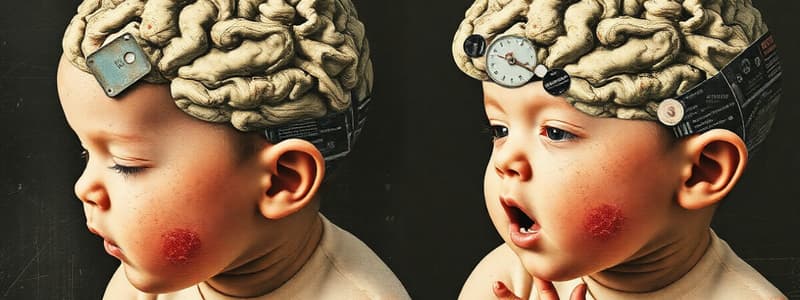Podcast
Questions and Answers
How does skin conductance relate to fear and anxiety in infants?
How does skin conductance relate to fear and anxiety in infants?
- Increased skin conductance predicts happiness.
- Low skin conductance indicates a tendency towards anxiety.
- Low skin conductance corresponds to high anxiety levels.
- Increased skin conductance may lead to anxiety later. (correct)
What role does the left frontal cortex play in emotional responses?
What role does the left frontal cortex play in emotional responses?
- It is active when individuals withdraw due to fear.
- It indicates higher vulnerability to stress.
- It is linked to the pursuit of reward and happiness. (correct)
- It is associated with sadness.
What can be inferred about uninhibited toddlers with low sympathetic nervous system activity?
What can be inferred about uninhibited toddlers with low sympathetic nervous system activity?
- They exhibit increased emotional sensitivity.
- They are more anxious in new environments.
- They are likely to have increased empathetic responses.
- They might be at-risk for aggressive behavior. (correct)
What is the primary purpose of emotions in infants according to John Bowlby?
What is the primary purpose of emotions in infants according to John Bowlby?
At what age does anger typically begin to develop in infants?
At what age does anger typically begin to develop in infants?
What factor leads to an infant expressing anger?
What factor leads to an infant expressing anger?
Which group do the emotions pain, sadness, disgust, and fear belong to?
Which group do the emotions pain, sadness, disgust, and fear belong to?
How do infants learn about emotions?
How do infants learn about emotions?
Which behaviors can indicate how an infant responds to frustration?
Which behaviors can indicate how an infant responds to frustration?
What emotional responses are associated with the Behavioral Activation System (BAS)?
What emotional responses are associated with the Behavioral Activation System (BAS)?
What factor is indicated as a predictor of empathy in early childhood?
What factor is indicated as a predictor of empathy in early childhood?
Which aspect of empathy was studied in children aged 8 to 16 months?
Which aspect of empathy was studied in children aged 8 to 16 months?
What does the term 'Still-Face Paradigm' generally refer to in emotional development?
What does the term 'Still-Face Paradigm' generally refer to in emotional development?
What emotional capacity begins to develop in infants around 8 months of age?
What emotional capacity begins to develop in infants around 8 months of age?
Which aspect of parenting is highlighted in the work of Kiff, Lengua, and Zalewski (2011)?
Which aspect of parenting is highlighted in the work of Kiff, Lengua, and Zalewski (2011)?
What element of brain development is discussed in the study by Kok et al. (2015)?
What element of brain development is discussed in the study by Kok et al. (2015)?
Which age group is primarily discussed in the context of emotional development according to Kopp and Neufeld (2003)?
Which age group is primarily discussed in the context of emotional development according to Kopp and Neufeld (2003)?
What do the authors identify as a contributing factor to anger development in children?
What do the authors identify as a contributing factor to anger development in children?
Flashcards
Anger (4-6 months)
Anger (4-6 months)
The infant's goal-directed action is blocked, typically by another person.
Fear (7 months)
Fear (7 months)
The infant perceives the situation as threatening.
Emotions as communication
Emotions as communication
Infants communicate their needs through emotional expressions.
Universality of facial expressions
Universality of facial expressions
Emotional expressions are universally recognized across cultures.
Signup and view all the flashcards
Emotions associated with threat (BIS)
Emotions associated with threat (BIS)
These emotions are associated with the Behavioral Inhibition System (BIS), which is activated when an individual experiences threat.
Signup and view all the flashcards
Emotions associated with reward (BAS)
Emotions associated with reward (BAS)
These emotions are associated with the Behavioral Activation System (BAS), which is activated when an individual experiences reward.
Signup and view all the flashcards
Anger as frustration
Anger as frustration
Anger is a negative emotion that results from the frustration of pursuing a reward.
Signup and view all the flashcards
Anger and secondary circular reactions
Anger and secondary circular reactions
Infants begin to show anger around 4 months, coinciding with Piaget's stage of secondary circular reactions, where they engage in goal-directed actions.
Signup and view all the flashcards
Theory of mind
Theory of mind
The ability of a child to understand and respond to the intentions and goals of others.
Signup and view all the flashcards
Behavioral Inhibition System (BIS)
Behavioral Inhibition System (BIS)
A system in the brain that is activated when an individual experiences threat or potential danger, leading to emotions like fear, anxiety, or apprehension.
Signup and view all the flashcards
Behavioral Activation System (BAS)
Behavioral Activation System (BAS)
A system in the brain that is activated when an individual experiences potential reward or positive outcomes, leading to emotions like excitement, joy, or motivation.
Signup and view all the flashcards
Behavioral Genetics
Behavioral Genetics
The study of how genes and environment interact to influence development, particularly focusing on the impact of genetics on social development.
Signup and view all the flashcards
Parental Sensitivity
Parental Sensitivity
The ability of parents to respond to their child's cues and provide appropriate care and support.
Signup and view all the flashcards
Neurodevelopment
Neurodevelopment
The process of understanding the structure and function of the brain, including its development across different stages of life.
Signup and view all the flashcards
Cognitive-Behavioral Therapy (CBT)
Cognitive-Behavioral Therapy (CBT)
An approach to therapy that emphasizes the role of thoughts, feelings, and behaviors in mental health, often used to treat conditions like borderline personality disorder.
Signup and view all the flashcards
Infant Vocal Development
Infant Vocal Development
The development of language and communication skills in infants, including the production of both intentional and spontaneous vocalizations.
Signup and view all the flashcards
Historical Linguistics
Historical Linguistics
The process of identifying the evolutionary relationship between languages and the history of their development.
Signup and view all the flashcards
Cognitive Theories of Gender Development
Cognitive Theories of Gender Development
Theories that explain how children develop an understanding of gender roles and identities, often focusing on cognitive processes like schema formation and social learning.
Signup and view all the flashcards
Still-Face Paradigm
Still-Face Paradigm
A research method where a caregiver interacts normally with an infant, then suddenly becomes unresponsive, looking away and remaining still.
Signup and view all the flashcards
Sense of Agency
Sense of Agency
The subjective experience of being the author of one's own actions and thoughts.
Signup and view all the flashcards
Empathy
Empathy
The ability to understand and share the feelings of others.
Signup and view all the flashcards
Sensitive Period for Language
Sensitive Period for Language
A sensitive period for language development, where learning a second language is easier and more efficient.
Signup and view all the flashcards
Neuroanatomy of Speech and Language
Neuroanatomy of Speech and Language
The brain structures and processes involved in speech and language comprehension.
Signup and view all the flashcards
Altruism in Offspring Care
Altruism in Offspring Care
The biological inclination to care for offspring, driven by evolutionary pressures.
Signup and view all the flashcards
Heart Rate Variability in Infants
Heart Rate Variability in Infants
Variations in heart rate patterns while infants pay attention to stimuli.
Signup and view all the flashcards
Conversational Exposure and Language
Conversational Exposure and Language
The amount of spoken words a child hears, influencing their language development.
Signup and view all the flashcards
Temperament
Temperament
Individual differences in behavioral styles and emotional reactivity.
Signup and view all the flashcards
Empathy Development in Infancy
Empathy Development in Infancy
The emergence of empathy between 8 to 16 months, showing concern for others' distress.
Signup and view all the flashcards
Electroencephalogram (EEG)
Electroencephalogram (EEG)
Measuring brain wave activity through electrodes placed on the scalp. It reflects how different parts of the brain communicate and work together.
Signup and view all the flashcards
Frontal EEG Asymmetry
Frontal EEG Asymmetry
The difference in brain wave activity between the left and right frontal cortex. More asymmetry means the right side is more active.
Signup and view all the flashcards
Right Frontal Cortex and BIS
Right Frontal Cortex and BIS
The right frontal cortex is associated with the Behavioral Inhibition System (BIS), which is responsible for fear, withdrawal, and avoiding potential threats.
Signup and view all the flashcards
Left Frontal Cortex and BAS
Left Frontal Cortex and BAS
The left frontal cortex is associated with the Behavioral Activation System (BAS), which is responsible for pursuing rewards, motivation, and positive emotions.
Signup and view all the flashcards
Skin Conductance
Skin Conductance
Measured through electrodes placed on the skin. Increased sweat caused by sympathetic nervous system activation (like during fear or stress).
Signup and view all the flashcardsStudy Notes
Infant/Toddler Psychosocial Development
- Infants exhibit attraction to comforting, stimulating situations and withdrawal from unpleasant stimuli.
- The Behavioral Approach System (BAS) is active when infants experience positive emotions; the Behavioral Inhibition System (BIS) is active during negative emotions.
- Emotional responses are limited at birth because brain circuits are not fully formed.
Emotional Development in Infants and Toddlers
- Infants initially express two basic emotions: attraction and withdrawal
- Interest/curiosity is demonstrated by three months
- Surprise is displayed by six months
- Infants display other emotions like joy, pain, sadness, disgust, anger, and fear at differing ages
- Joy, a positive emotion, is experienced by two months
- Pain is a negative reaction at birth
- Sadness is a negative reaction that is observed by three months
- Disgust is a negative reaction at birth
- Anger occurs between four and six months
- Toddlers show fear around seven months
Temperament
- Temperament involves individual differences in children's behavior observed from birth, these differences persist through development
- Caregivers are often surprised when they see variations in their children's reactions
- Thomas and Chess identified three temperament types: easy (40%), slow-to-warm-up (15%), and difficult (10%).
- Goodness of fit refers to the match between a child's temperament and the parenting style
The Biopsychology of Temperament
- Temperament is demonstrated over the first year of life; including responses to pleasure and frustration
- Biological markers of temperament include frontal EEG asymmetry, skin conductance, and heart rate
- Frontal EEG asymmetry reflects differences in brain activity between the right and left sides of the brain, indicating emotional reactivity
- Skin conductance is related to fear and stress through sympathetic nervous system activation
- Heart rate variability (RSA) is from parasympathetic nervous system activity, related to attention
- Studies show that infant's biological markers change as they develop and that temperament is linked to behavioral and emotional problems
Infant Social Behavior
- Emotions are an important part of the mother-infant system; enabling communication of needs.
- Infants learn about emotions through others' responses to their needs.
- Primary emotions include pain, sadness, disgust, fear (BIS); and interest, surprise, joy, anger (BAS)
The attachment system
- Infant behaviors associated with seeking security and care from caregivers are important to infants.
- Infants are born with reflexes that allow them to signal needs, and caregivers distinguish between the types of crying
- Infants develop voluntary behaviors and learning behaviors, and have a preference for familiar caregivers by 9 months
- The "still face" paradigm examines how infants respond to caregivers' unresponsiveness
Separating Families at the Border
- Separating families at the border has detrimental effects on children, increasing risks of depression, anxiety, PTSD, etc.
- Children experiencing separation exhibit attachment issues and mental health problems
Child's Play and Direct Evidence for Internal Working Models of Caregiving
- Infants, toddlers, and children demonstrate and understand social dominance though play and interaction with caregivers.
Empathy in Infants and Toddlers
- Infants exhibit emotional contagion (crying when others cry) starting around 8 months
- Toddlers show increasing concern for distressed others around 8-16 months
- Caregiver sensitivity and responsiveness affects empathy development, as well as cognitive and language skills
The Dominance System
- Toddlers display competition for resources and status, demonstrating a sense of agency, which regulates their own behavior and allows them to care for others
Language Development
- Language development is influenced by genetics, maturation, and experience
- Infants readily learn language through observation
- Key components are phonemes (smallest unit of sound), morphemes (smallest units of meaningful language), and syntax (rules of grammar)
- Pragmatics involve social rules related to communication
- Infants exhibit infant-directed speech behaviors used by caregivers
The Caregiving Behavioral System
- Infants and caregivers engage in reciprocal interactions
- Children develop schemas of caregiver behavior, which affect future expectations
Assessment of Infant-Toddler Development
- Assessment tools like the Neonatal Behavioral Assessment Scale (NBAS) and Ages and Stages Questionnaire are used.
- Tools like the Early Language Milestone Scale assess language development from birth to 36 months
- Other tests are used to diagnose autism spectrum disorder in toddlers.
Autism Spectrum Disorder (ASD) in Toddlers
- ASD is a developmental disability with symptoms that appear early in childhood.
- Children with ASD have challenges with social skills, repetitive behaviors, and communication.
- Signs include difficulty with eye contact, imitation, sharing attention, and sensory differences.
- Early intervention is very important
Studying That Suits You
Use AI to generate personalized quizzes and flashcards to suit your learning preferences.




